New Boston Historical Society
New Boston, New Hampshire
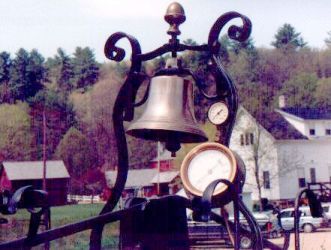
The Fire of 1887
and
Historic Fire-fighting Equipment
To give the alarm during the fire, Lottie Adams and Marcy Dale ran to the Church on the Hill to ring its bell, using their combined weight to pull the rope. (Read about this church and bell at the Churches and Meetinghouses page.)
The clerk of New Boston's Constitution #2 Fire Company wrote at the time: "The company with the engine was promptly at hand and done all that was possible for them to do... A messenger was sent to Goffstown for help. They responded with 150 men and an engine but not in time to be of any practical good - only to play [water] on the ruins. The loss of property by this fire is estimated to be $50,000."
Ironically, Abram Wason's mill survived the fire unscathed. However, when Wason contemplated restarting his mill a few days after the fire he was "encouraged" to leave town instead. J. R. Whipple later bought the mill, tore it down, and built the Creamery in its place.
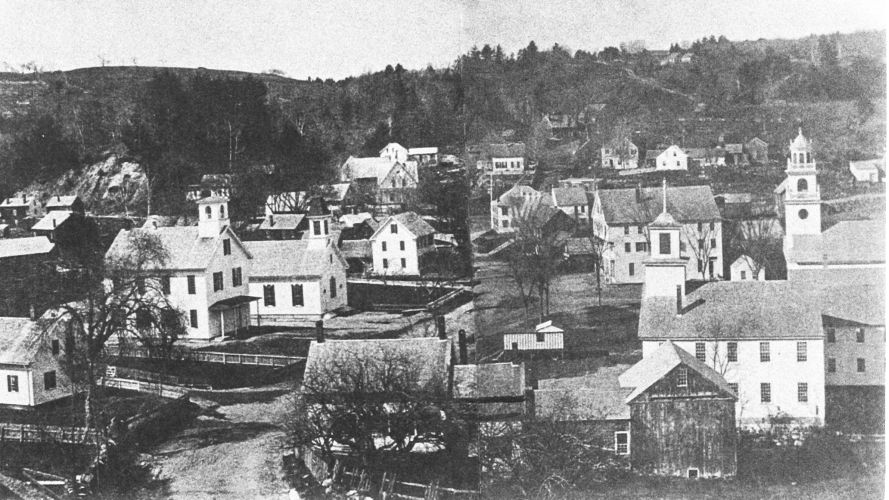
New Boston village before the fire, looking west from Meetinghouse Hill
The four steepled buildings are, from left to right: the Village School, the Presbyterian Chapel, the Town Hall, and the Baptist Church.
The white 3-story building beyond the Town Hall is Atwood's Store.
Every building in the lower half of this photo burned on May 11th.
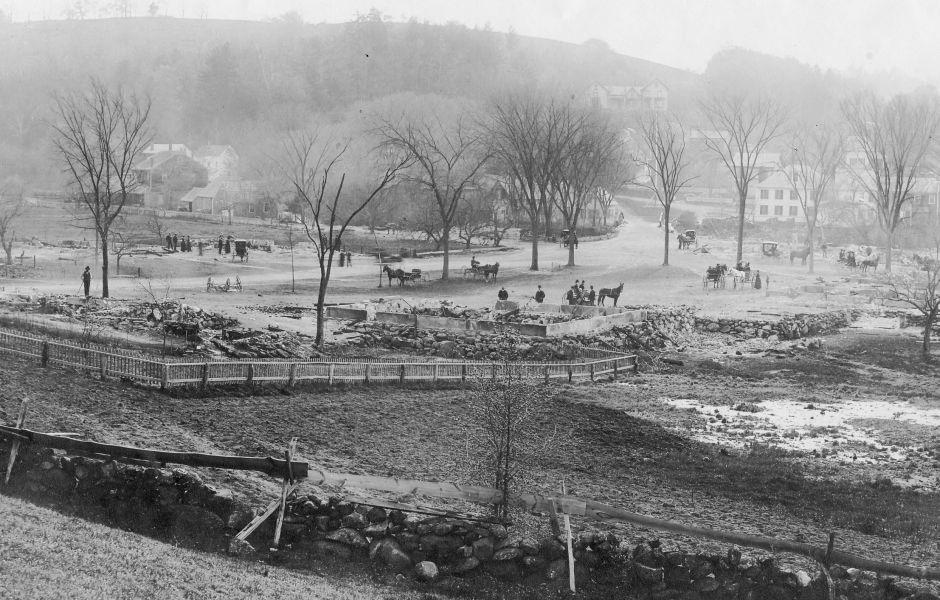
Looking west from Meetinghouse Hill at the ruins of the Town Hall.
The white building with black window shutters is the Columbian Hotel, on the other side of the river.
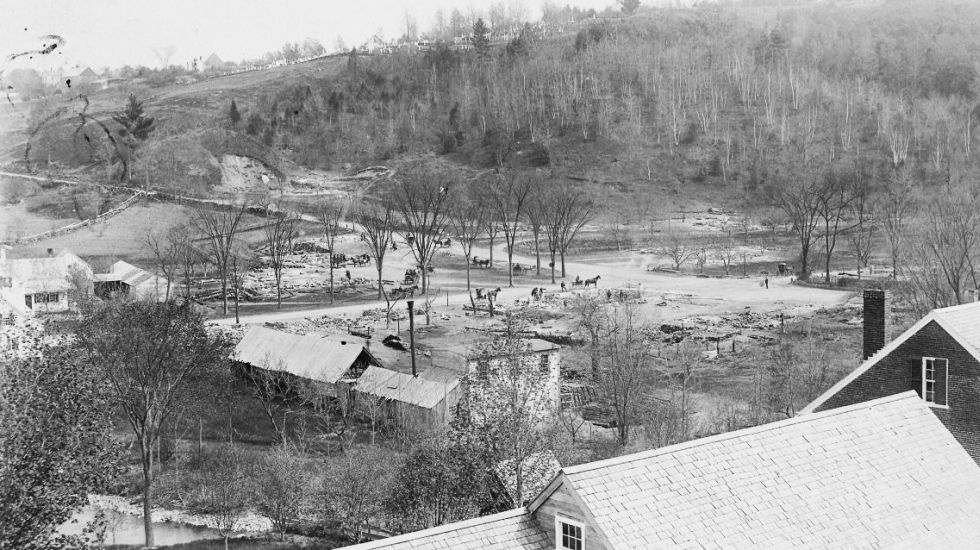
The village after the fire of 1887, from above High Street, looking southeast
towards Meetinghouse Hill and the Cemetery.
Abram Wason's workshop with its metal stovepipe is in the middle of the photo.
The white house to the left was saved from the fire by wet blankets placed on its roof.

Google Earth view of New Boston village today. Outlined in red is the area that was burned in 1887.
The green arrow shows the viewpoint of the 1887 photographer from above the brick-sided house on High Street.
Wason's workshop was located near the tip of the green arrow.
Historic Fire-fighting Equipment
In colonial America, the traditional firefighting technique was to form a "bucket brigade", a line of people who passed buckets between a water source and a burning building. If you ever have tried to throw a heavy bucketful of water you will know that it is difficult to throw water very far or very high. Also, there was not always a convenient river or pond near a house fire. A better way was needed, so inventors developed the fire engine. A design popular in the 1800s was the "hand tub" which is a copper-lined water tub mounted on wheels and equipped with hand-operated pumps and a fire hose. The primary firefighting equipment in New Boston from 1872 until 1924 was the Constitution #2 hand tub which is now on display in the Historical Society building.
Early hand tubs were filled by bucket brigades but by the mid-1800s suction pumps were used whenever a source of water was available. The "brakes" which are long wooden poles carried along the sides of the hand tub as it hurried to a fire would be attached perpendicular to the ends of the see-saw-like pumping arms so that teams of men could work together to provide a steady stream of water.
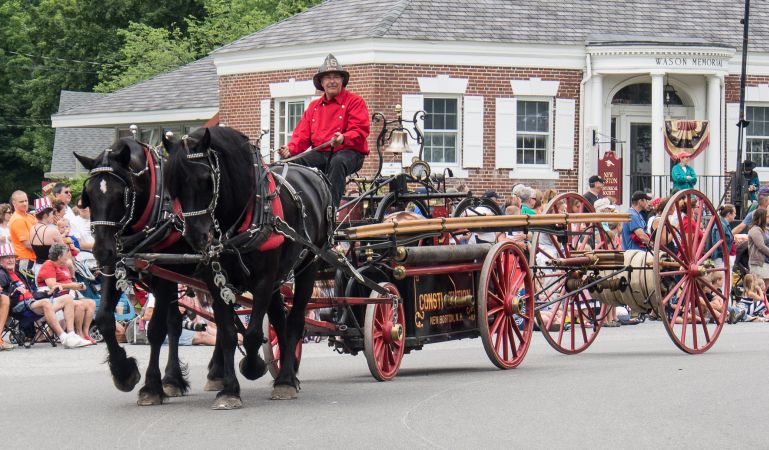
Bob Lapointe drives the Constitution #2 in 2015. (John Poltrack photo)
The wooden brakes are in their travel position.
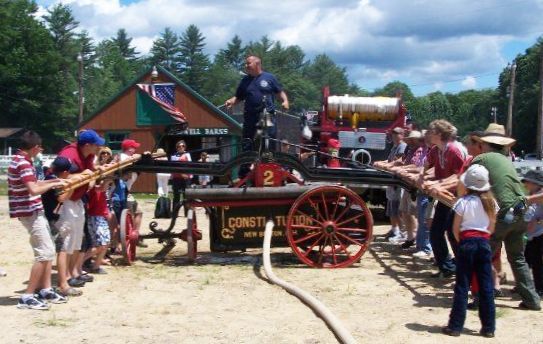
Hands-on training with the Constitution #2 in 2009. Brakes are now extended for use. (Lisa Cramb photo)
Note the "crane neck" frame to which the front axle is attached. This enables the hand tub to turn in its own length.
Imagine pumping at one stroke per second to produce pressure four times the 30 PSI we produced for a few seconds on July 4, and then imagine doing this for an hour as a real fire might be fought. Matthew Lee wrote for The History Channel: "Ten men pushing on the brakes could last only five minutes or so if they pumped hard. At a large fire, it took three or more teams of men to run one engine: five minutes on, ten minutes off."
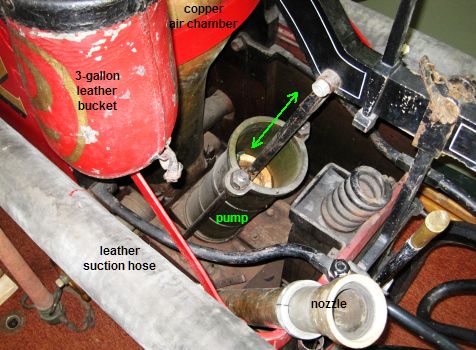
The Constitution #2 hand tub is stored empty but is filled with 200 gallons of water for use. One of its two pumps is shown.
Both pumps are mounted at a 30-degree angle to the central valve-chest and air chamber,
and are actuated by the up-and-down motion of the pumping arms to which the long wooden brakes are attached.
The copper air chamber stores pressure so that a steady stream of water can be "played" upon the fire.
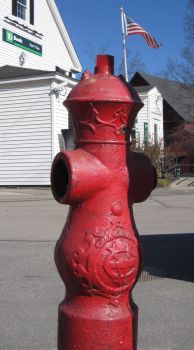 A 19th-Century Fire Hydrant
A 19th-Century Fire HydrantThe Great Fire of 1887 burned down the fire house and the hose needed to use the Constitution #2 hand tub. Therefore when J.R. Whipple helped New Boston rebuild its village center he wanted to improve the town's ability to fight fires.
In 1895 Whipple built a state-of-the-art Creamery to process milk from his dairy farm. There he installed a steam-powered water pump connected to a network of new fire hydrants around the village. The pump produced enough pressure to send a stream of water over the church steeple. With practice, an eight man team could lay hose and begin pumping water in less than three minutes.
One original hydrant remains today in front of the bank, where The Tavern once stood. This fire hydrant was made by the Chapman Valve Mfg. Co. in the 1890s. If you would like more information about fire hydrants, please visit the website www.firehydrant.org which claims to be "the #1 fire hydrant information resource." This website will answer any questions you might possibly have about fire hydrant barrels, bonnets and fluting.
The hydrant near the bank is no longer functional. If you are worried about being run over by a bank customer, you may inspect a matching fire hydrant in the safety of the Historical Society museum, on display near the Constitution #2 hand tub. The museum's hydrant, donated by John Young, is unpainted.
The New Boston Fire Association displays some of its historic firefighting equipment in the museum.
We thank the Association for the use of the following photos and text.
Constitution #2 Hand Tub
This Hunneman Hand Tub was made in Boston in 1851. It was one of the finest in firefighting equipment at that time and was sold to the Salem Fire Department, Salem Massachusetts. In 1872, the Salem Fire Department decided to purchase a steam engine1 and New Boston acquired the hand tub. It was named the Constitution #2.

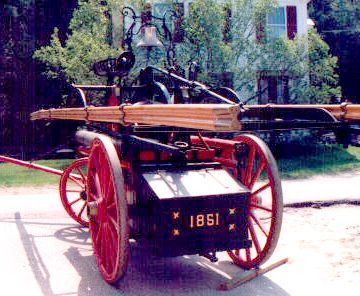
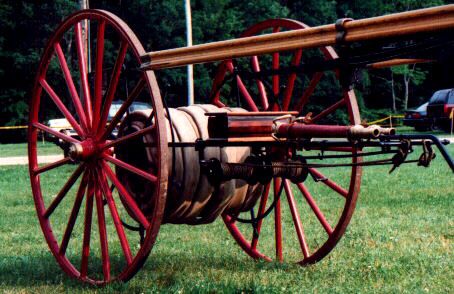
Constitution #2 hand tub and Hose Reel
Pinball
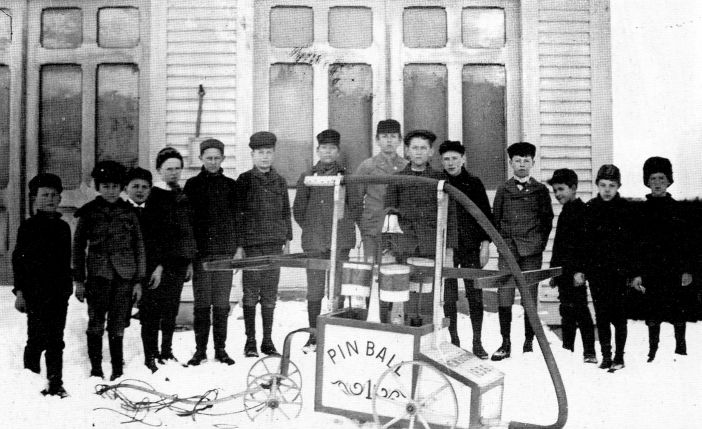
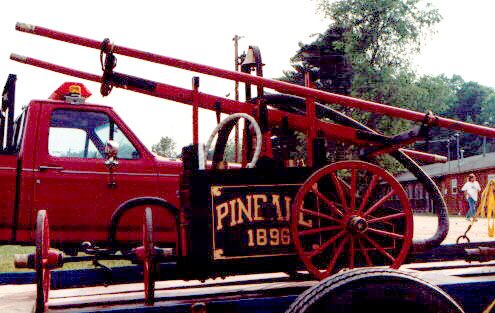
Pinball hand pumper from 1896
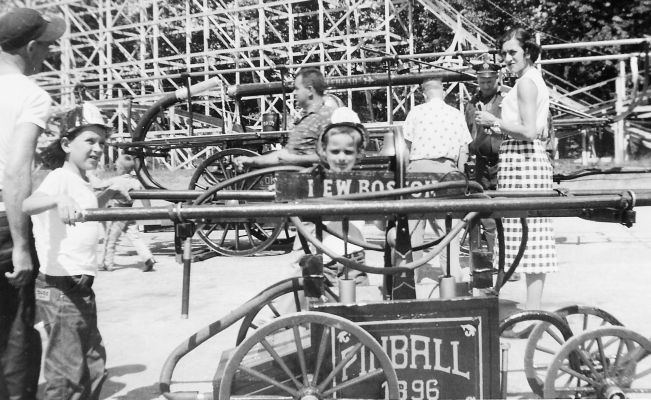
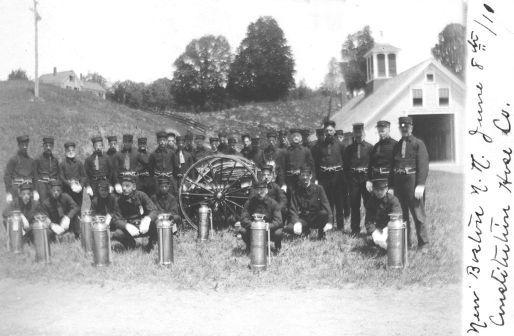
The Fire Department in 1911
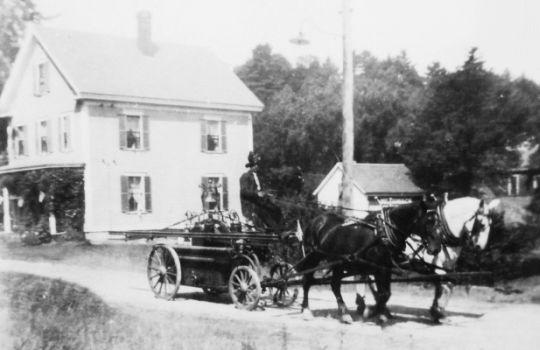
The Constitution #2 on Mill Street
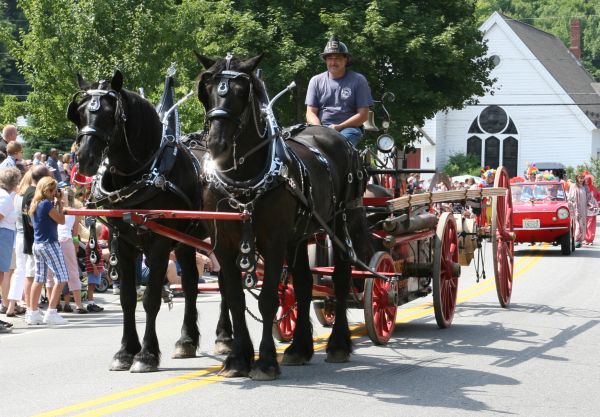
The Constitution #2 in a 4th of July parade (2007)
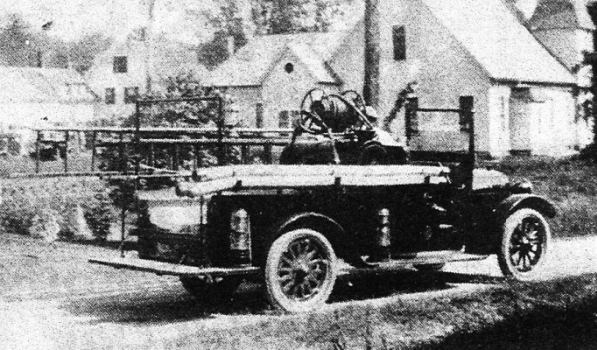 Footnotes:
Footnotes:1. The Salem Fire Company sold New Boston its hand tub because a steam-powered fire engine was considered more modern. New Boston never acquired a steam-powered fire engine. The Constitution #2 was our primary fire-fighting machine from 1872 until 1924, when New Boston purchased its first motorized fire engine: a second-hand 3/4-ton REO "Speed-Wagon". This was a truck powered by a 4-cylinder gas engine and is not to be confused with the 1970's rock band of the same name.
(Bill Fiske's diary says the truck arrived in June of 1925.)
2. To illustrate the usefulness of a good hose reel: an article in the June 1952 "New Hampshire Profiles" magazine mentions the Lawrence Number 2, a hand tub similar to the Constitution #2 but manufactured a year earlier in 1850. It was purchased by the town of Amherst, NH in 1859 and named after Deacon Aaron Lawrence who donated funds for its purchase. Ironically, one of the first fire calls to which it responded was to the deacon's house. "Due to insufficient hose, the house was almost a total loss."
Another fine example of a Hunneman Fire Engine
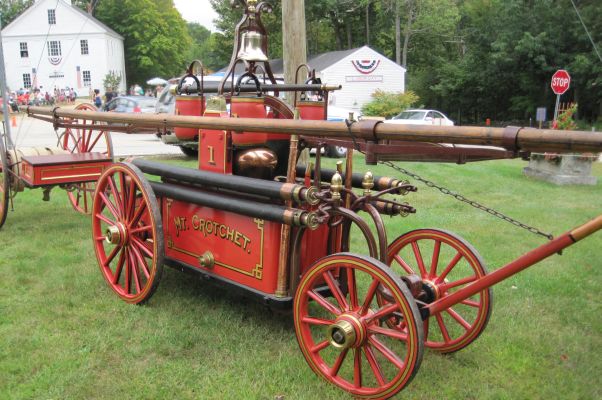
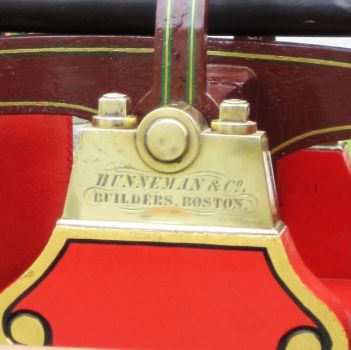
Francestown's 1850 "Mt. Crotchet" Hunneman hand tub was recently restored.
The Francestown Improvement and Historical Society is building a new barn to display this engine.
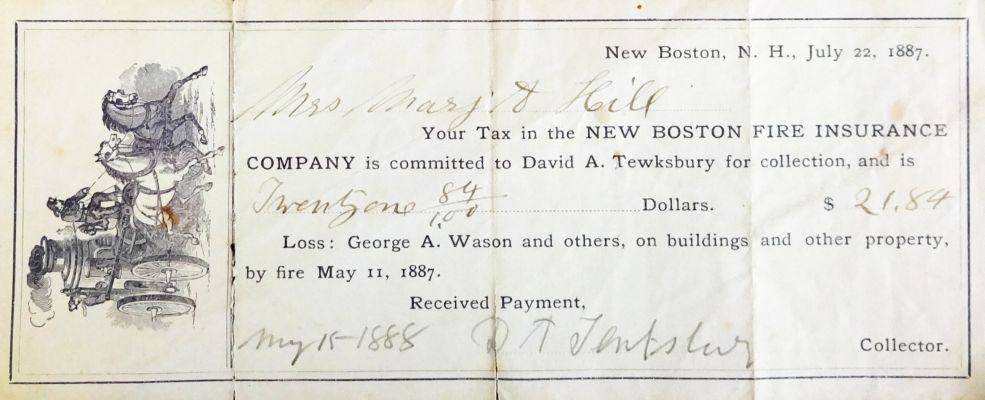
In 1989, Rena Davis compiled and printed a history of 144 years of fire fighting in New Boston, N.H. (1845-1989).
"Under the Fire House Roof" is now on-line as a searchable PDF file.
